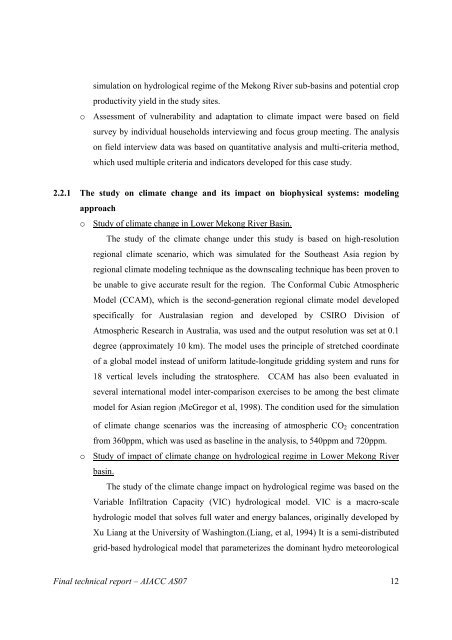Final Technical Report - weADAPT
Final Technical Report - weADAPT
Final Technical Report - weADAPT
- No tags were found...
You also want an ePaper? Increase the reach of your titles
YUMPU automatically turns print PDFs into web optimized ePapers that Google loves.
simulation on hydrological regime of the Mekong River sub-basins and potential crop<br />
productivity yield in the study sites.<br />
o Assessment of vulnerability and adaptation to climate impact were based on field<br />
survey by individual households interviewing and focus group meeting. The analysis<br />
on field interview data was based on quantitative analysis and multi-criteria method,<br />
which used multiple criteria and indicators developed for this case study.<br />
2.2.1 The study on climate change and its impact on biophysical systems: modeling<br />
approach<br />
o Study of climate change in Lower Mekong River Basin.<br />
The study of the climate change under this study is based on high-resolution<br />
regional climate scenario, which was simulated for the Southeast Asia region by<br />
regional climate modeling technique as the downscaling technique has been proven to<br />
be unable to give accurate result for the region. The Conformal Cubic Atmospheric<br />
Model (CCAM), which is the second-generation regional climate model developed<br />
specifically for Australasian region and developed by CSIRO Division of<br />
Atmospheric Research in Australia, was used and the output resolution was set at 0.1<br />
degree (approximately 10 km). The model uses the principle of stretched coordinate<br />
of a global model instead of uniform latitude-longitude gridding system and runs for<br />
18 vertical levels including the stratosphere. CCAM has also been evaluated in<br />
several international model inter-comparison exercises to be among the best climate<br />
model for Asian region (McGregor et al, 1998). The condition used for the simulation<br />
of climate change scenarios was the increasing of atmospheric CO 2 concentration<br />
from 360ppm, which was used as baseline in the analysis, to 540ppm and 720ppm.<br />
o Study of impact of climate change on hydrological regime in Lower Mekong River<br />
basin.<br />
The study of the climate change impact on hydrological regime was based on the<br />
Variable Infiltration Capacity (VIC) hydrological model. VIC is a macro-scale<br />
hydrologic model that solves full water and energy balances, originally developed by<br />
Xu Liang at the University of Washington.(Liang, et al, 1994) It is a semi-distributed<br />
grid-based hydrological model that parameterizes the dominant hydro meteorological<br />
<strong>Final</strong> technical report – AIACC AS07 12
















